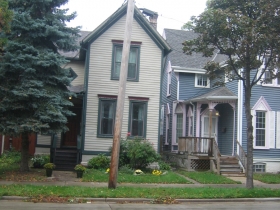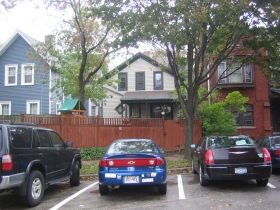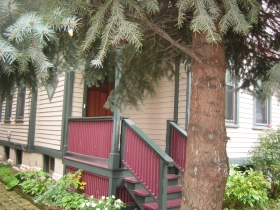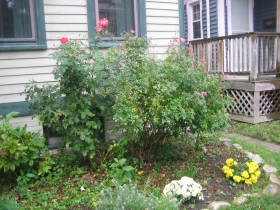Jon Richards’ Very Old Style Home
The legislator and candidate for attorney general has a home near Brady Street that probably goes back to the 1870s.

Jon Richard’s East Side Home. Photo by Michael Horne.
This modest 19th century home with two street frontages on a triangle-shaped block is a good example of the staying power of a well-maintained single family residence located in the midst of the ever-changing Brady Street neighborhood.
The city records say this home, the residence of Rep. Jon Richards, who announced his candidacy for Attorney General this week, was built in 1898. He bought the home in 1997 before his marriage to Andrea Rowe Richards, who lives there with him and their young son Alex.
Yet the structure in its present form appears in the 1894 Sanborn Fire Insurance Map, and as early as September 1888 its owner, identified only as Mr. Benjamin, took out a permit “to build a basement under the present building.”
Most likely the building already had a 4 foot stone foundation, which still exists. Mr. Benjamin probably simply added the 3 feet of brick foundation that lies above the original.
Anyway, around these parts a stone foundation is a sign of a building that dates from settlement to the late 1870s, which is when this home was probably built.
As a building inspector noted sometime in the 1940’s “This is a very old place tho well kept up.”
On September 5th, 1969, when the current owner was celebrating his 6th birthday somewhere out in Waukesha, this home was listed for sale at a price of $12,900.
“This is an exceptionally clean and well-maintained home near good transportation and shopping. Good area for renting rooms.”
Such was the assessment of Amanda Kapsner (or perhaps Japsner, the city record is unclear). On July 23rd, 1957 she went to the city saying she “wants 3 roomers. Now has 2.”
Although there are today three rooming houses within a block of this building, it was spared the indignity of that fate, or of demolition as happened in the early 20th century when this area was a hotbed of multifamily housing construction. This was due in part to the aforementioned “good transportation and shopping,” which then included a nearby streetcar. That part of history is likely to repeat itself as the Milwaukee Streetcar glides along.
This “Residence Old Style having 1.5 stories” is 42 feet by 26 feet, although the “rear half is low” It is of frame construction on a 30 foot by 77 foot lot. Despite its frontage on two streets, it has but “medium traffic,” according to the city assessor. And despite its history of good maintenance, it is rated at “C-” as to condition.
That half-stone, half-brick basement is fully 780 square feet, as is the first floor with a kitchen, living room, dining room and half-bath.
Up there in the 644 square foot half-story is a full bathroom and three entire bedrooms, giving the home 1,424 square feet of living area on a 2,310 square foot lot.
The building has had quite a number of owners since old Mr. Benjamin back in 1888. They included James and Beatrice Muzik, Joseph and Amanda Kapsner or Japsner along with James Christnacht and John O. Skageberg whose plans in 1984 to park a motor vehicle on the premises “must be denied,” the city decided.
“The fact that your property has two street frontages and very little yard space makes it impossible for you to achieve compliance with the ordinance,” wrote Orval Hummitzch, District Building Construction Manager.
[Note to reader: Do you realize the only two people with common names in this story are Mr. Benjamin and Rep. Richards? No offense to the Muziks, the Kapsners (or Japsners) or Orval Hummitzch, but this is getting to be a bit much.]
In 1986 Brenton E. Gallina put up a fence on the property, which makes sense, since otherwise the property is a natural shortcut. Eventually he got a permit for the fence, which remains in one incarnation or another. The small backyard is still large enough for an attractive playhouse for the Richardses’ son Alex, who is still a little guy, but active enough that the fence will soon prove no barrier to his leaps and bounds.
The property is about as nicely landscaped as its small scale will permit. A giant spruce tree lacks the stature needed to qualify as the City Holiday Tree, but could make a nice mast if Richards wants to build a sailboat. Potted mums add a festive seasonal touch, while a spreading rose bush just does not know how to stop flowering. Hostas, also in bloom, decorate the side yard and the rear of the property. Get rid of the tree.
The home’s assessment history shows that for a long time ownership of a home near Brady Street, despite the ease of shopping and transportation, was no guaranteed investment. The home was assessed at $2,500 from 1925-1931, dropping to $2,200 from 1933 – 1939, when things were tough for everybody. It reached a value of $4,200 in 1959 and is assessed today at $25,300 for the land, $136,100 for the improvements for a total of $161,400, down from its high of $211,800 in 2006. Not bad for Richards, who paid $86,800 for the home on September 1st, 1997, an early 34th birthday present to himself. He subsequently remodeled the kitchen and the half-bath. On September 27th 1999, after Richards had settled in, the inspector came calling for his sale review. “No response to letters” he had sent Richards. What kind of constituent communication is that? Still the inspector was able to note the home was well maintained, with a “New 2 tone paint job,” and a “Newer roof.”
Taxes on the property were $4,641.62 and are paid in full.
The Rundown
- Style: “Residence Old Style”
- Location: City of Milwaukee
- Neighborhood: Lower East Side
- Subdivision: Cambridge Subdivision
- Walk Score: 91 out of 100. “Walker’s Paradise.” Of course it is — it’s Brady Street!
- Street Smart Walk Score: 96 out of 100 “Walker’s Paradise”
- Transit Score: 53 out of 100. “Good Transit” Better than good — there is a bus right outside the door. A Green Line Express Bus! And just wait for the streetcar.
- Size: 1,424 well-maintained square feet.
- Year Built: Before 1894 (likely before 1888; possibly 1870s), remodeled 2002..
- Assessed Value: Land — $25,300; Improvements — $136,100 Total $161,400
- Taxes: $4,641.62, paid in full.
Photo Gallery
House Confidential Database
| Name | City | Assessment | Walk Score | Year |
|---|---|---|---|---|
| Name | City | Assessment | Walk Score | Year |
























Nice column, nice place, but Holy Cow, those taxes seem high. However, at least Milwaukee has the lake and a functional school system. St. Louis has neither.
Thanks for the good laugh Todd, in fact it was far more than just a good laugh, I actually couldn’t stop laughing for about ten straight minutes when I read your comment referring to how high the taxes were! Trust me, if you own a house in the city of Milwaukee and you’re paying under $5k in taxes, you’re getting a DEAL! Yes, we do have an awesome lake (not sure what that that would do to move taxes up or down) and MPS should definitely have you on their Christmas-OOPS!-I mean HOLIDAY card list for being so kind as to refer to our public schools as “functional”, that’s got to be the best compliment they’ve heard in years!
Just wondering too, what is so bad about St. Louis anyway? I have several friends who live or lived in STL, one is an old friend who grew up in Milwaukee and lived in several different cities, moving to STL from DC due to a great job offer coming her way. After maybe a year in STL, I recently saw her posting a pic on Facebook of the arch, taken from the IL side of the river with some comment about being so darn happy to leave for good! Another friend grew up in the STL suburbs and always said that the suburbs to the west are quite nice but never had much of anything good to say about the city of St Louis itself! What’s the story there anyway???
I lived in Waukesha from 1988 to 2002, then in Milwaukee until 2009, and am aware the taxes in the City of Milwaukee are on the high side. Mine only topped out at about $4000 a year, though, at the very most, so $4600 on a property assessed at about $160,000 is just somewhat higher than I had gotten used to while living there. I’m not sure what mine here will wind up being eventually, as they are currently abated down to something like $800/year because of redevelopment credits in a blighted area (which the entire downtown essentially is).
I listened to Belling and Weber for years and realize that MPS has horrendous problems, but the St. Louis City Schools are in another league of dysfunction and are among the worst in the country. The schools in northern St. Louis County (referred to here as North County) are also mostly attrocious, with two of them currently having lost state accreditation. The St. Louis City Schools had lost accreditation for five years (2007 – 2012) and currently have some sort of provisional accreditation, but it’s been exposed that they fudged/lied/misrepresented how well the school system is actually performing, and they will almost certainly lose accreditation the next time it comes up for official review.
The St. Louis City Schools are so bad that it is generally considered unconscionable for a middle class family to send their kids there, so when children get to school age, these families are faced with the choice of either moving out of the city, or sending the kids to private schools, of which there are a substantial number of, partly to fill in the void in the educational system caused by the dysfunctional public schools in the city and in North County. The public schools in South and West County are fine and are relatively similar to what you would see in metro Milwaukee outside of MPS.
I’m told downtown St. Louis has improved greatly from its worst, and while it’s not a complete hellhole, it definitely isn’t as nice, modern, and well maintained as downtown Milwaukee is. There is a certain amount of badly decayed urban infrastructure it is impossible to avoid seeing, but the trend is definitely positive, with a noticeable improvement even in the four years I’ve lived here. I think the people are very nice; although, somewhat more reserved than people in Milwaukee are. It’s not the last city I would ever want to live in, and there are certainly many things I like about the area, but from my perspective, I would rather be back in Milwaukee, high taxes and all.
Odd that this has turned to taxes, but the solution to high property taxes isn’t cutting spending… it’s changing how the revenue is collected.
Currently, there are thousands of homes worth less than $30,000 that pay a couple hundred dollars of taxes a year. These areas also need high amounts of police services, along with the regular maintenace any area does.
If we can figure out a way to get more taxes out of these homes, through fees/usage/you name it, then taxes will drop on the middle class in this city.
Until then you’re howling at clouds.
One thing I am thankful for is that I’m not spending my career in the world of big city public schooling, it does seem like someone who’s job is to climb a mountain with a giant boulder chained to their waist! As much as I am quick at times to slam MPS and its dismal performance record over the last 20 or more years, I must admit that the people working at all levels in MPS face a daunting task, attempting to educate kids, many of whom come from irreparably broken homes with “parents” who couldn’t care less if they pass or fail or if they even show up at school, just as long as they’re out of the house for the day. I came to the conclusion a while ago that such a large school system ought to be broken up into several smaller units that would hopefully be easier to manage and could be run much more efficiently without the layer upon layer of bureaucracy that always seems to come along with any public (and many private) organizations that grow so large.
Now, Tim’s point is interesting and I agree with 90% of it, EXCEPT the opening line about cutting spending somehow not being the solution to reduce our ridiculous property burden here. We’ve got to get a handle on spending in the city, there is fat that needs to be cut, I’ve heard many anecdotes about various examples of it from friends on the inside of city gov’t as well as seeing several great examples myself. Take a field trip to one of the city dumps sometime. I’m at one of them every so often and always have to laugh and nearly cry at the same time because they’re ALWAYS not just overstaffed but ridiculously overstaffed, with a whole bunch of people always just hanging out, scattered around the yard area, never doing a damn thing! Its downright hilarious how bad and blatant the waste is there, right up until I remember my annual tax bill and instantly go from laughing to either crying or nearly exploding!
Tim is spot on however about how our city spreads its tax burden and basically uses all of the middle and especially upper class residents to pay for nearly the entire bill we get for our policy of hand holding all of the people in the city who either need some financial help or (more likely) simply choose to live off of the rest of us.
Since I’m in the real estate business full time, mostly on the residential side, I know property tax numbers inside and out and they stink in the city of Milwaukee. What used to amount to basically an extra fraction of what you’d pay each month on your mortgage has now morphed into a major expense that NEVER goes away and is never retired like your mortgage eventually is. Take a look sometime at the “property data” section of the city’s website sometime and pull up some records for some of the fancier streets in the city, like Lake Drive or maybe Terrace or Wahl Avenues on the fashionable east side. Sure, those are some very nice homes on those very nice streets, but look at the annual total tax bills, you’ll see $20,000 bills and more, sometimes much more, for house after house after house! Then pick any random street on the north side and do the same thing. You’ll see bills in the hundreds and the ones you find in the thousands are usually the ones that are delinquent. You’ll also see that many of the bills have “specials” listed on them, usually that’s when they didn’t pay their water bill again, so it just gets tacked on to the tax bill, again. Or it could be for city fines for things like having old cars parked for months on end in the yard, not cutting the lawn, leaving a big, rat-infested pile of garbage in the back yard that finally the city has to come and remove, which of course they charge for and when (surprise!) the bill’s never paid then it also gets tacked on to the tax bill.
Tim’s also right about the city services and who uses them. Obviously, MPS is a major portion and when you’re looking at those bills on Terrace and Wahl Ave’s, remember that of the families with kids on those streets, they likely only have a few kids and almost certainly choose to pay for them to attend private schools. Back on the north side, house after house will have kids on top of kids. Of course when you look at the number of police calls for each area, you’ll see that the MPD spends the vast majority of its time in the neighborhoods that pay little in taxes as well, not just on service calls but also where do you think the detectives are investigating major crimes? I could go on and on about all of the other various handout programs run by the city as well that go nearly entirely to the inner city, but then I’d be typing all night! (in fairness, some of them like the rent assistance program are reimbursed to varying degrees by the state and federal governments, but then where do you think they get their money from??!!)
Yes, we could in theory start changing how and where we collect city taxes from to better reflect where the money is spent, but how in the world would you ever collect on those bills? The city already has one delinquency after another in the inner city and when they are forced to foreclose on a property due to unpaid taxes, there’s usually not much there in the end either because nearly no one wants to own anything in those areas. Beyond that, try taking a look at some of the now city-owned tax foreclosed houses in the “hood” as I’ve done before, usually you’ll find a totally neglected and trashed out shell of what once was a nice home. If the former owners didn’t destroy the place then you can count on the neighborhood clowns coming through and stripping anything of value like any metal plumbing, first the copper, then anything metal, wiring, metal siding, etc, etc. Many of these houses aren’t worth buying even for a dollar. (which they often do sell for!)
My answer (and I know its not an easy solution, I’m thinking real big picture here) is that somehow we need to get people back to the idea of personal responsibility and actually pulling their own weight! I wouldn’t doubt that many of those who now spend their lives from cradle to grave sucking off of the rest of us have not even a clue as to all of the various ways they’re being supported by those of us who work and pay tax bills. Beyond being clueless even of what they’re receiving directly, they’re likely clueless that pretty much any economic development in the areas they inhabit (and usually destroy) ONLY happens when its heavily subsidized, once again by the rest of us. So you want to develop some land or something in Brookfield or Hartland? Go right ahead but don’t expect anything from the local gov’t other than bills for the various permits and approvals you’ll need. Want to develop something in “the hood”? Well that’s a whole different story because you’ll certainly need a lot of free money from the gov’t for that project to make any financial sense at all!